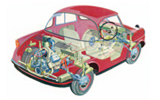
Mazda launched its first passenger car, the R360 Coupe, throughout Japan on May 28, 1960. The launch coincided with a period of improved income levels and changing lifestyles, and the beginning of the boom in demand for car ownership in Japan. The automotive industry was in full swing, brought to fruition by such factors as the first All Japan Motor Show in 1954 (later to become the Tokyo Motor Show), the national car concept put forward by the Ministry of International Trade and Industry (MITI — currently the Ministry of Economy, Trade and Industry) in 1955, trade liberalization and other measures that stimulated the economy. That said, the cars of the period, even the micro-mini cars for the masses, were expensive and hard to come by. However, people still dreamed of having their own car and Mazda's R360 Coupe was born from this desire, breaking the mold of the micro-mini car of that period.
In the development of the R360 Coupe, Mazda used new technology and thoroughly raised its manufacturing efficiency. In so doing, it managed to introduce models with very low sticker prices — 300,000 yen for the manual transmission version and 320,000 yen for the first car in the country equipped with a torque converter. By May 20, 1960, just prior to the R360 Coupe's launch, Mazda had already received orders for as many as 4,500 units. The car's popularity increased even further after the launch, and by August Mazda was selling in excess of 2,000 units per month. In December of that year the company saw record-breaking sales of 4,090 units. The total production figure for 1960 amounted to 23,417 units, giving Mazda a 64.8% production share of the micro-mini car market. In helping to fulfill people's dreams of owning a car, the R360 Coupe played a leading role in the development of Japan's motorization.

The Mazda R360 Coupe.
The attraction of the R360 Coupe was not price alone. It featured a torque converter and a host of other cutting-edge technologies Mazda had developed. The R360 Coupe was also the first micro-mini passenger car to be equipped with a four-stroke engine, realizing better durability and fuel economy than its two-stroke counterpart. The engine also used a substantial amount of magnesium alloy. Combined with a light monocoque body, light alloy hood and other weight-saving measures, this made the R360 Coupe the lightest car produced in Japan at only 380 kilograms, with concomitant gains in fuel economy and driving performance. The car had a four-wheel independent suspension system employing torsion rubber for a nimble and comfortable ride. The stylish and functional coupe form enclosing the 2+2 cabin also led the field in Japan's car design. A car so advanced it completely broke with convention, the R360 Coupe heralded the future of Mazda's passenger cars.

Excerpts from the original catalogue.


